How to get rid of spider mite on greenhouse crops and houseplants
Summer’s well on the way and my greenhouse tomato and cucumber crops are looking promising, but this year I’m noticing the early onset of a greenhouse pest that has the potential to totally devastate everything it attacks: spider mite. These are very tiny pests that feed off the plant’s circulatory system, literally sucking the life out of them. Their ability to destroy large plants is out of all proportion to their size – they are smaller than grains of flour or dust particles, and are barely visible to the naked eye. I have seen very large specimen plants (such as an exotic banana plant) almost wiped out and left unchecked spider mites will happily destroy tomato plants and, in my case, threaten this year's cucumber crop too.
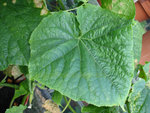 Healthy cucumber leaf [click to see]
Healthy cucumber leaf [click to see]
 Cucumber spider mite damage [click to see]
Cucumber spider mite damage [click to see]
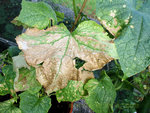 Foliage death caused by spider mite [click to see]
Foliage death caused by spider mite [click to see]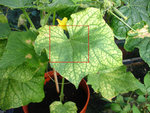 Yellowing caused by spider mite sap damage. Fine webs will be visible in the area shown [click to see]
Yellowing caused by spider mite sap damage. Fine webs will be visible in the area shown [click to see]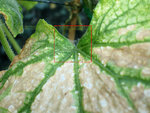 Misting with water reveals the webs [click to see]
Misting with water reveals the webs [click to see]
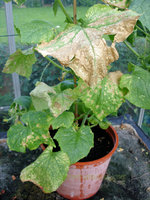 It's war! Spider mite can destroy a large plant [click to see]The first signs of spider mite are usually on foliage. It starts to go dappled and yellow as the chlorophyll is drained away by the sap-sucking pests, and it may result in totally desiccated patches of greenery as though the plant has been scorched.
It's war! Spider mite can destroy a large plant [click to see]The first signs of spider mite are usually on foliage. It starts to go dappled and yellow as the chlorophyll is drained away by the sap-sucking pests, and it may result in totally desiccated patches of greenery as though the plant has been scorched.
Spider mites tend to gather more on the underside of leaves, between the veins. They also group on the base and stalk of the leaf, and if you look very closely you may see tiny, dust-like particles moving around. The presence of spider mite can often be revealed by spraying leaves with a fine mist of water: this will highlight very fine cobwebs that form on the ‘valley’ of leaves around the base and stalk. If you see these tell-tale signs, then it’s important to act straight away before they spread and destroy the whole plant in a few short weeks (which they will!), then spreading to other plants nearby.
Old-fashioned remedies include spraying with a water/ washing-up liquid (a drop or two only), or regular misting with water as spider mites thrive in hot, dusty conditions. At most, this might set them back a little, but it's not 100% effective and it’s necessary to use a more aggressive treatment to deal with the problem thoroughly.
I find many common amateur pesticide sprays have little effect these days. Compared to 20 or 30 years ago, pesticide resistance is now very high making pest control (aphids, whitefly and spider mites especially) far more difficult than it ever used to be.
Start by removing heavily infested foliage and destroy it. Two products to start with (remember, as we’re treating a food crop, sprays must be food-safe) are Bug Clear Ultra for flowers, fruit and veg, and Resolva Bug Killer. Be sure to spray the undersides of leaves and leave axils/ stems where spider mites flourish. There are steep restrictions on how often you can spray food (2-3 times maximum, say), and how long you have to wait before harvesting crops.
The problem of spider mite has plagued my greenhouse for a couple of years, and I have to say I’ve tried both of these products with limited results: in fact they are not specific for spider mite but can provide some useful control. Of the general garden-centre products, Scott's Bug Clear for Fruit & Veg is probably the best bet. It's a rape-seed oil based product that is 100% natural and is worth a try: mix it with water in a pressure sprayer.
Otherwise the next stage is to try specific products to kill spider mite. One suggestion is Spidermite Control (SMC), a natural, oily spray that claims to suffocates spider mites on contact (the same way Scott's Bug Clear for Fruit & Veg does). It is organic, natural, friendly to bees, safe for kids, wildlife. It also claims to beat whitefly and aphid.
An alternative is Safer’s Trounce, a Canadian product that's a contact insecticide with a natural chemical formula. It claims to be the only product with pyrethrins (insecticide) and fatty acids (breaks down pests on contact). A 500mL bottle of Trounce makes up to 10L, and a 1L RTU spray is also available. I would suggest this is likely to be a better all-rounder, especially for use on indoor plants.
A third way is to use a natural predator that dines on spider mites, and Phytoseiulus is sold in packs but they have been very heavily criticised for being very expensive and performing poorly.
I have wasted a small fortune on ineffective Ready To Use (RTU) sprays sold by garden centres. As SMC points out, one mature female spider mite can produce up to one million offspring in a month, so now it’s time to press the nuclear button – I’ve opted to try Trounce and I’ll keep you posted how well this spider mite pesticide does in my greenhouse, so be sure to check back.
At the end of the season I'll empty the greenhouse and fumigate it with a sulphur candle or two (if I can get any - they seem to be banned by the EU now), to kill off any overwintering pests. Below are links to the above products on Amazon, plus technical info links.

- Scott's Bug Clear for Fruit & Veg https://www.lovethegarden.com/products/pests-disease/bugclear-fruit-veg-concentrate
- Trounce http://www.growthtechnology.com/product/trounce/
- SMC information http://www.spidermitecontrol.com/general-info/
 Alan W
Alan W
Trounce Insecticide for spidermite control
I've given my greenhouse cucumber crop its first spray (maximum of four) of Trounce insecticide, an organic and biodegradable food-safe contact spray (diluted 50 ml per litre). It mixed very well in a pressure sprayer and is not unpleasant, oily or smelling of chemicals. (Next door's doberman came over and had a good sniff though.) I mixed two litres and it coated the plant leaves very well. Be sure to spray the undersides and leave stalks thoroughly.
The hot and sunny weather means temperatures in the greenhouse have soared to 100°F+ which encourages spider mite to flourish. Keep misting with water in between times to help discourage them, and it's good for plants too.
Here's a couple of photos showing spidermite attacking leaves in this very hot weather - watch for the presence of webs in the valley of leaves.
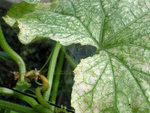 Spidermite really thrives in hot sunny dry weather [click to see]
Spidermite really thrives in hot sunny dry weather [click to see]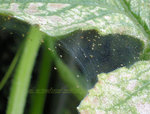 close-up of advanced spidermite infestation [click to see
close-up of advanced spidermite infestation [click to see
Using Trounce RTU (Ready To Use) Spray on some indoor plants (Black Eye Susan) also seems to have stopped the spidermite, but at a penalty with the flowers themselves being damaged. The plant seems to be flourishing and flowering happily again though, so the motto is to be prepared for some short term foliage and flower damage on delicate plants, and preferably test on a small area of plant first if you can.
I'll post more as it happens.
 Alan W
Alan W
A week later, there is no sign of spider mite on the sprayed/ infested areas but it has appeared elsewhere on the crops (tell-tale yellowing of leaves). The spider mite travel along the horizontal stalks and spread to other plants, so it's time for another dousing with more Trounce in a pump-up sprayer. I mixed another two litres (= 100 mls of Trounce, 50mls per litre).
So far I've used four litres so obviously the RTU trigger spray wouldn't have been economically viable. They say four treatments maximum per food crop, and I'm hoping that this second treatment will keep the problem under control until harvest time.
 Alan W
Alan W
'Useful control'
A month later, after two applications of Trounce the spider mite have been killed off at the point of contact, but spider mite managed to spread to other cucumber plants -- looking closely, I could see the little pests running up and along the horizontal stalks and support wires and they were busily populating my cucumber crop further 'upstream'.
The first signs - mottled leaves - started to appear on fresh foliage growth so it's necessary to spray again - my third application and hopefully nip the latest invasion in the bud. I'm allowed maybe one more spray with the pressure sprayer after that (= four, maximum) before harvest time. Spdier mite also spread to some small rose bushes in pots in the same greenhouse. I used the trigger-spray RTU Trounce on those, with good effect.
Overall, I'm only slightly disappointed with the performance of Trounce but, as they state, it does give 'useful control' of spider mite. Being a contact-only pesticide, it's inevitable that it cannot wipe out the pest entirely (unlike a fumigant/ systemic product), but this is true for all such pesticides. The keyword is 'vigilance' and you should move fast as soon as the first signs of spider mite are detected. Trounce seems to be better than most products I have tried though.
This is an ongoing battle and I guess I'll have to gut the greenhouse after harvesting, maybe using Jeyes Fluid, to rid it of pests entirely!

Reader Comments